Hospitality Management 9: WHS System Report - Queensland Healthcare
VerifiedAdded on 2020/04/13
|15
|1675
|30
Report
AI Summary
This report provides an overview of the Work Health and Safety (WHS) system implemented at Queensland Healthcare Facility. It emphasizes the organization's commitment to patient and stakeholder safety, including students, volunteers, and contractors. The report details the need for a WHS system, its characteristics, and the relevant WHS legislation, including the NSW Work Health and Safety Act and Regulation. It outlines the facility's hazard management strategies, including the use of chemical registers and Safety Data Sheets (SDS), and the importance of health surveillance. The report also covers consultation with colleagues, existing agreements, machinery maintenance, and training issues. Furthermore, it describes the risk assessment and hazard identification processes, including sources of risk, aims of risk management, and responsibilities under the WHS system. The report concludes with an evaluation of the WHS system's effectiveness, including physical and HR costs, and references to relevant sources.
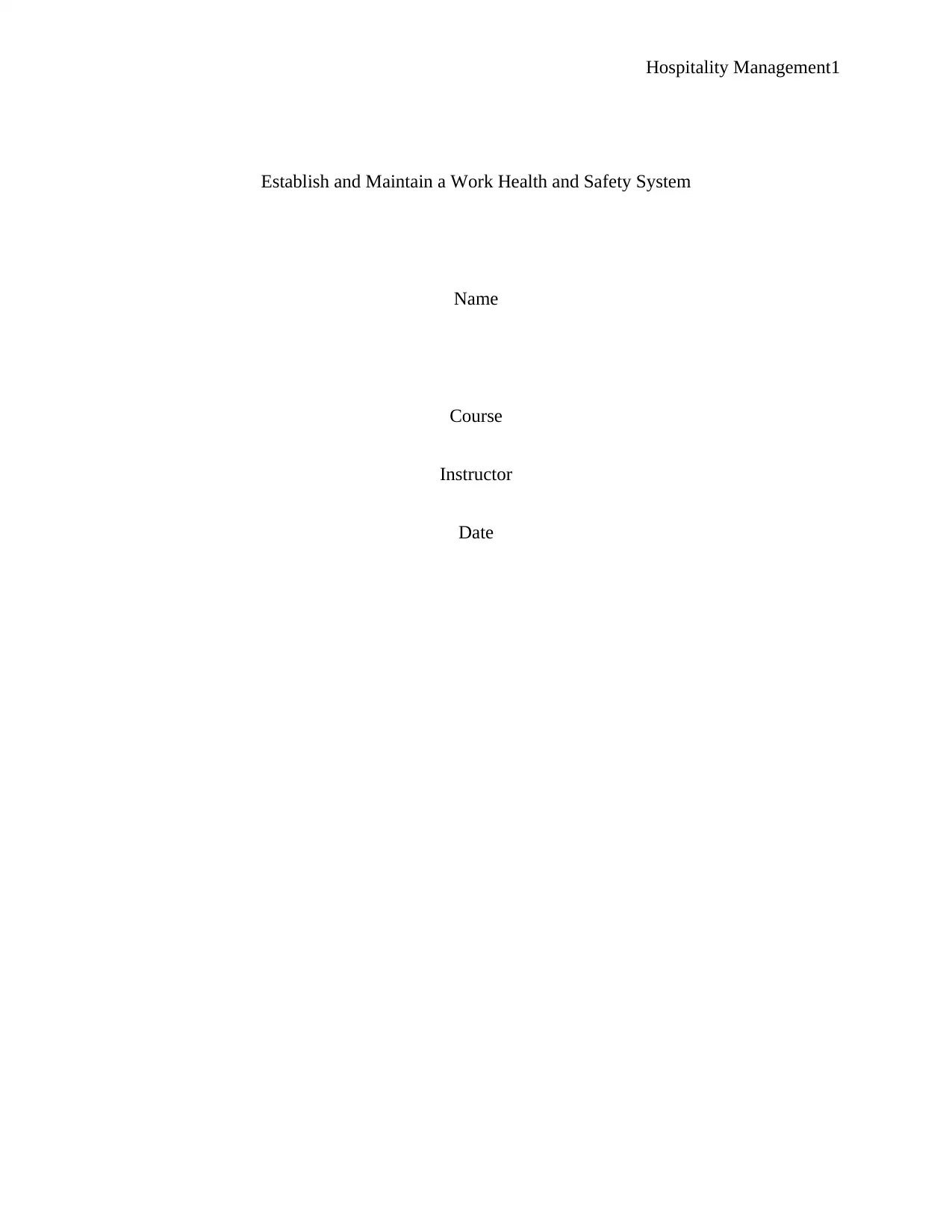
Hospitality Management1
Establish and Maintain a Work Health and Safety System
Name
Course
Instructor
Date
Establish and Maintain a Work Health and Safety System
Name
Course
Instructor
Date
Paraphrase This Document
Need a fresh take? Get an instant paraphrase of this document with our AI Paraphraser
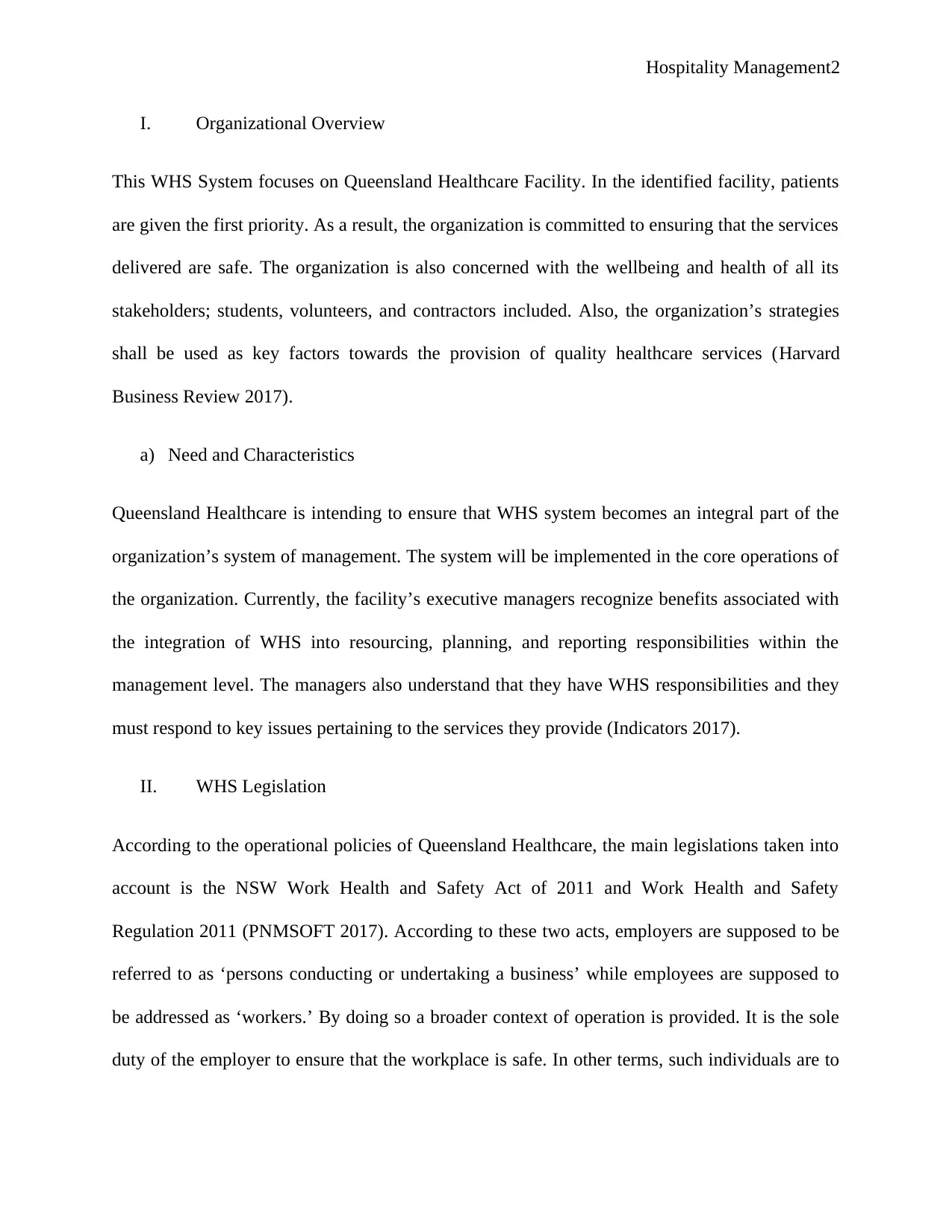
Hospitality Management2
I. Organizational Overview
This WHS System focuses on Queensland Healthcare Facility. In the identified facility, patients
are given the first priority. As a result, the organization is committed to ensuring that the services
delivered are safe. The organization is also concerned with the wellbeing and health of all its
stakeholders; students, volunteers, and contractors included. Also, the organization’s strategies
shall be used as key factors towards the provision of quality healthcare services (Harvard
Business Review 2017).
a) Need and Characteristics
Queensland Healthcare is intending to ensure that WHS system becomes an integral part of the
organization’s system of management. The system will be implemented in the core operations of
the organization. Currently, the facility’s executive managers recognize benefits associated with
the integration of WHS into resourcing, planning, and reporting responsibilities within the
management level. The managers also understand that they have WHS responsibilities and they
must respond to key issues pertaining to the services they provide (Indicators 2017).
II. WHS Legislation
According to the operational policies of Queensland Healthcare, the main legislations taken into
account is the NSW Work Health and Safety Act of 2011 and Work Health and Safety
Regulation 2011 (PNMSOFT 2017). According to these two acts, employers are supposed to be
referred to as ‘persons conducting or undertaking a business’ while employees are supposed to
be addressed as ‘workers.’ By doing so a broader context of operation is provided. It is the sole
duty of the employer to ensure that the workplace is safe. In other terms, such individuals are to
I. Organizational Overview
This WHS System focuses on Queensland Healthcare Facility. In the identified facility, patients
are given the first priority. As a result, the organization is committed to ensuring that the services
delivered are safe. The organization is also concerned with the wellbeing and health of all its
stakeholders; students, volunteers, and contractors included. Also, the organization’s strategies
shall be used as key factors towards the provision of quality healthcare services (Harvard
Business Review 2017).
a) Need and Characteristics
Queensland Healthcare is intending to ensure that WHS system becomes an integral part of the
organization’s system of management. The system will be implemented in the core operations of
the organization. Currently, the facility’s executive managers recognize benefits associated with
the integration of WHS into resourcing, planning, and reporting responsibilities within the
management level. The managers also understand that they have WHS responsibilities and they
must respond to key issues pertaining to the services they provide (Indicators 2017).
II. WHS Legislation
According to the operational policies of Queensland Healthcare, the main legislations taken into
account is the NSW Work Health and Safety Act of 2011 and Work Health and Safety
Regulation 2011 (PNMSOFT 2017). According to these two acts, employers are supposed to be
referred to as ‘persons conducting or undertaking a business’ while employees are supposed to
be addressed as ‘workers.’ By doing so a broader context of operation is provided. It is the sole
duty of the employer to ensure that the workplace is safe. In other terms, such individuals are to
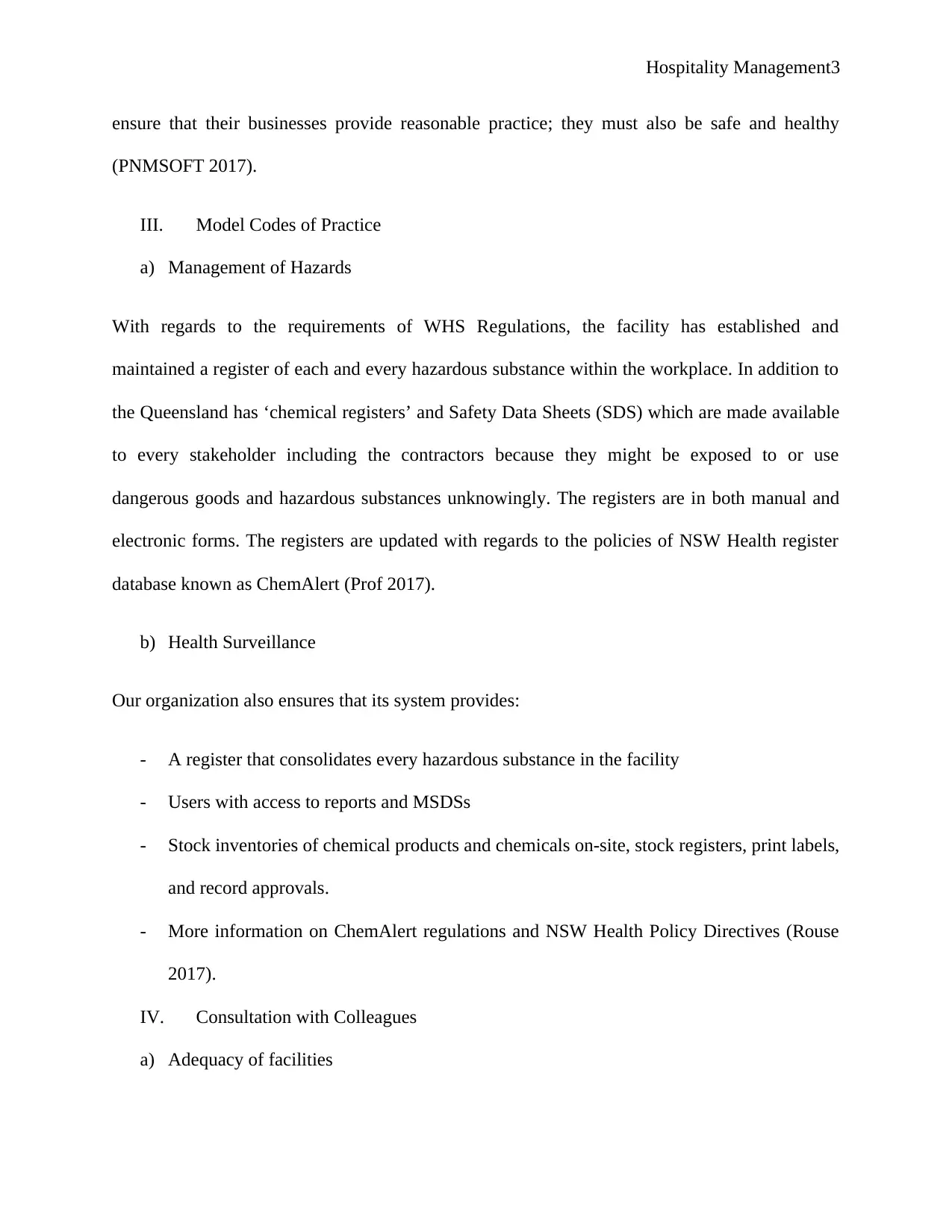
Hospitality Management3
ensure that their businesses provide reasonable practice; they must also be safe and healthy
(PNMSOFT 2017).
III. Model Codes of Practice
a) Management of Hazards
With regards to the requirements of WHS Regulations, the facility has established and
maintained a register of each and every hazardous substance within the workplace. In addition to
the Queensland has ‘chemical registers’ and Safety Data Sheets (SDS) which are made available
to every stakeholder including the contractors because they might be exposed to or use
dangerous goods and hazardous substances unknowingly. The registers are in both manual and
electronic forms. The registers are updated with regards to the policies of NSW Health register
database known as ChemAlert (Prof 2017).
b) Health Surveillance
Our organization also ensures that its system provides:
- A register that consolidates every hazardous substance in the facility
- Users with access to reports and MSDSs
- Stock inventories of chemical products and chemicals on-site, stock registers, print labels,
and record approvals.
- More information on ChemAlert regulations and NSW Health Policy Directives (Rouse
2017).
IV. Consultation with Colleagues
a) Adequacy of facilities
ensure that their businesses provide reasonable practice; they must also be safe and healthy
(PNMSOFT 2017).
III. Model Codes of Practice
a) Management of Hazards
With regards to the requirements of WHS Regulations, the facility has established and
maintained a register of each and every hazardous substance within the workplace. In addition to
the Queensland has ‘chemical registers’ and Safety Data Sheets (SDS) which are made available
to every stakeholder including the contractors because they might be exposed to or use
dangerous goods and hazardous substances unknowingly. The registers are in both manual and
electronic forms. The registers are updated with regards to the policies of NSW Health register
database known as ChemAlert (Prof 2017).
b) Health Surveillance
Our organization also ensures that its system provides:
- A register that consolidates every hazardous substance in the facility
- Users with access to reports and MSDSs
- Stock inventories of chemical products and chemicals on-site, stock registers, print labels,
and record approvals.
- More information on ChemAlert regulations and NSW Health Policy Directives (Rouse
2017).
IV. Consultation with Colleagues
a) Adequacy of facilities
⊘ This is a preview!⊘
Do you want full access?
Subscribe today to unlock all pages.

Trusted by 1+ million students worldwide
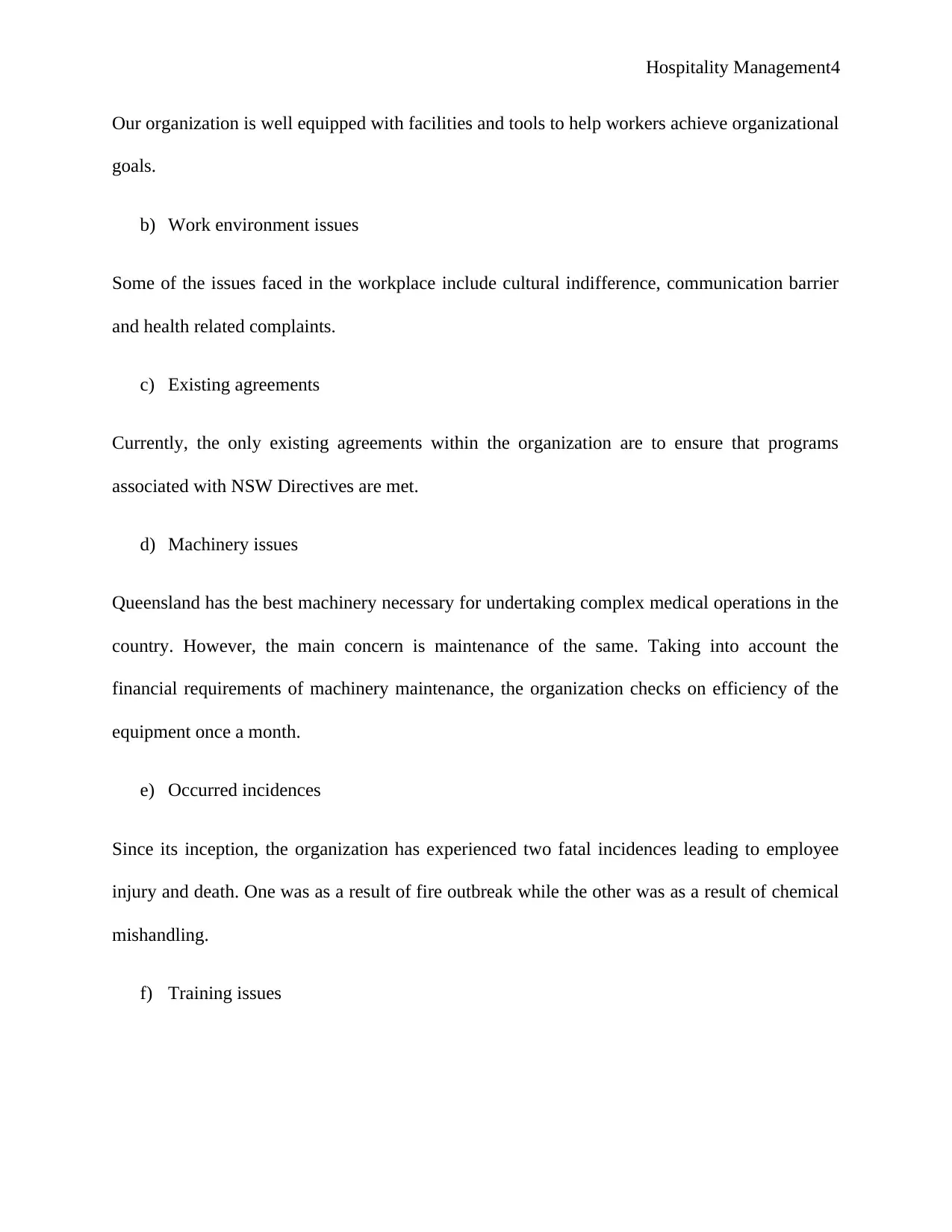
Hospitality Management4
Our organization is well equipped with facilities and tools to help workers achieve organizational
goals.
b) Work environment issues
Some of the issues faced in the workplace include cultural indifference, communication barrier
and health related complaints.
c) Existing agreements
Currently, the only existing agreements within the organization are to ensure that programs
associated with NSW Directives are met.
d) Machinery issues
Queensland has the best machinery necessary for undertaking complex medical operations in the
country. However, the main concern is maintenance of the same. Taking into account the
financial requirements of machinery maintenance, the organization checks on efficiency of the
equipment once a month.
e) Occurred incidences
Since its inception, the organization has experienced two fatal incidences leading to employee
injury and death. One was as a result of fire outbreak while the other was as a result of chemical
mishandling.
f) Training issues
Our organization is well equipped with facilities and tools to help workers achieve organizational
goals.
b) Work environment issues
Some of the issues faced in the workplace include cultural indifference, communication barrier
and health related complaints.
c) Existing agreements
Currently, the only existing agreements within the organization are to ensure that programs
associated with NSW Directives are met.
d) Machinery issues
Queensland has the best machinery necessary for undertaking complex medical operations in the
country. However, the main concern is maintenance of the same. Taking into account the
financial requirements of machinery maintenance, the organization checks on efficiency of the
equipment once a month.
e) Occurred incidences
Since its inception, the organization has experienced two fatal incidences leading to employee
injury and death. One was as a result of fire outbreak while the other was as a result of chemical
mishandling.
f) Training issues
Paraphrase This Document
Need a fresh take? Get an instant paraphrase of this document with our AI Paraphraser
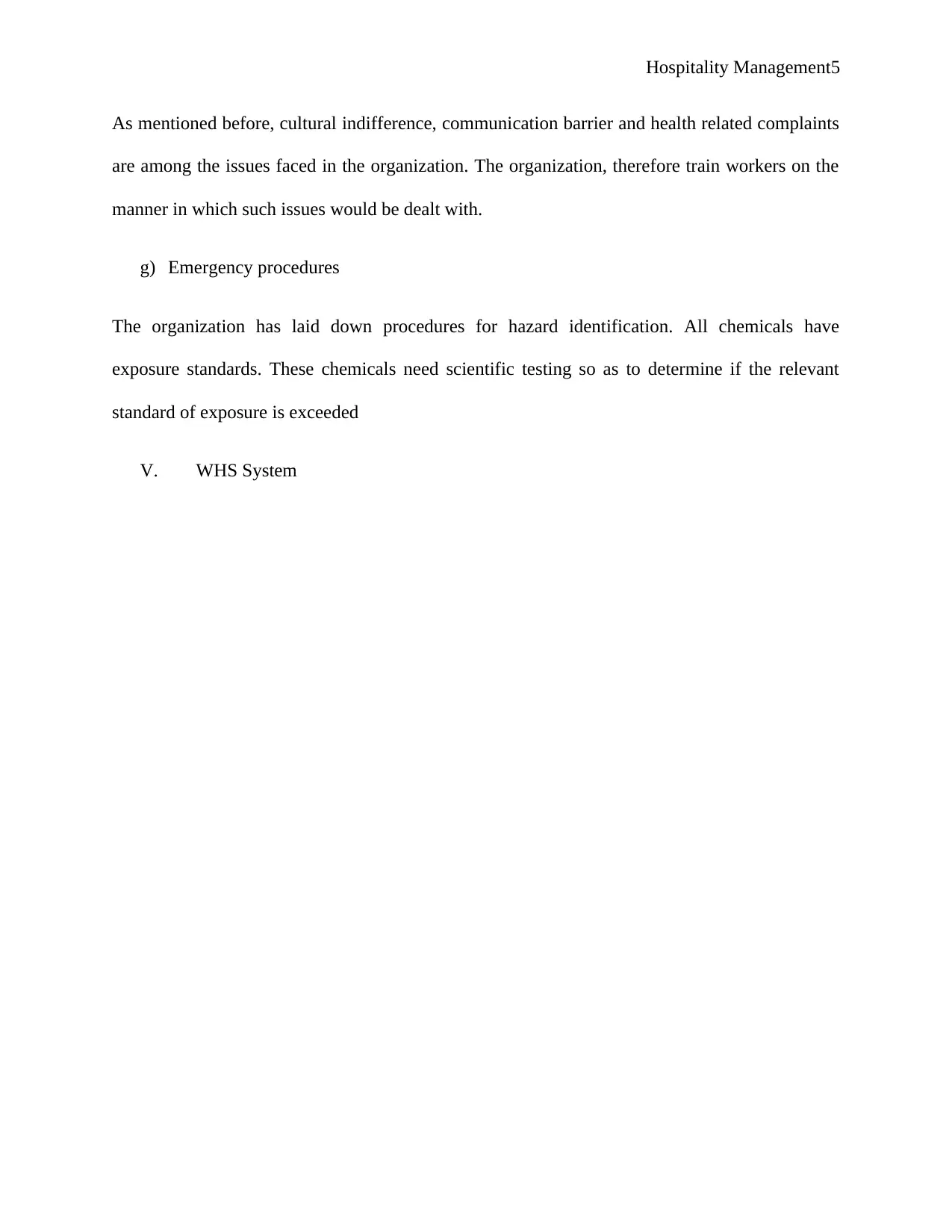
Hospitality Management5
As mentioned before, cultural indifference, communication barrier and health related complaints
are among the issues faced in the organization. The organization, therefore train workers on the
manner in which such issues would be dealt with.
g) Emergency procedures
The organization has laid down procedures for hazard identification. All chemicals have
exposure standards. These chemicals need scientific testing so as to determine if the relevant
standard of exposure is exceeded
V. WHS System
As mentioned before, cultural indifference, communication barrier and health related complaints
are among the issues faced in the organization. The organization, therefore train workers on the
manner in which such issues would be dealt with.
g) Emergency procedures
The organization has laid down procedures for hazard identification. All chemicals have
exposure standards. These chemicals need scientific testing so as to determine if the relevant
standard of exposure is exceeded
V. WHS System
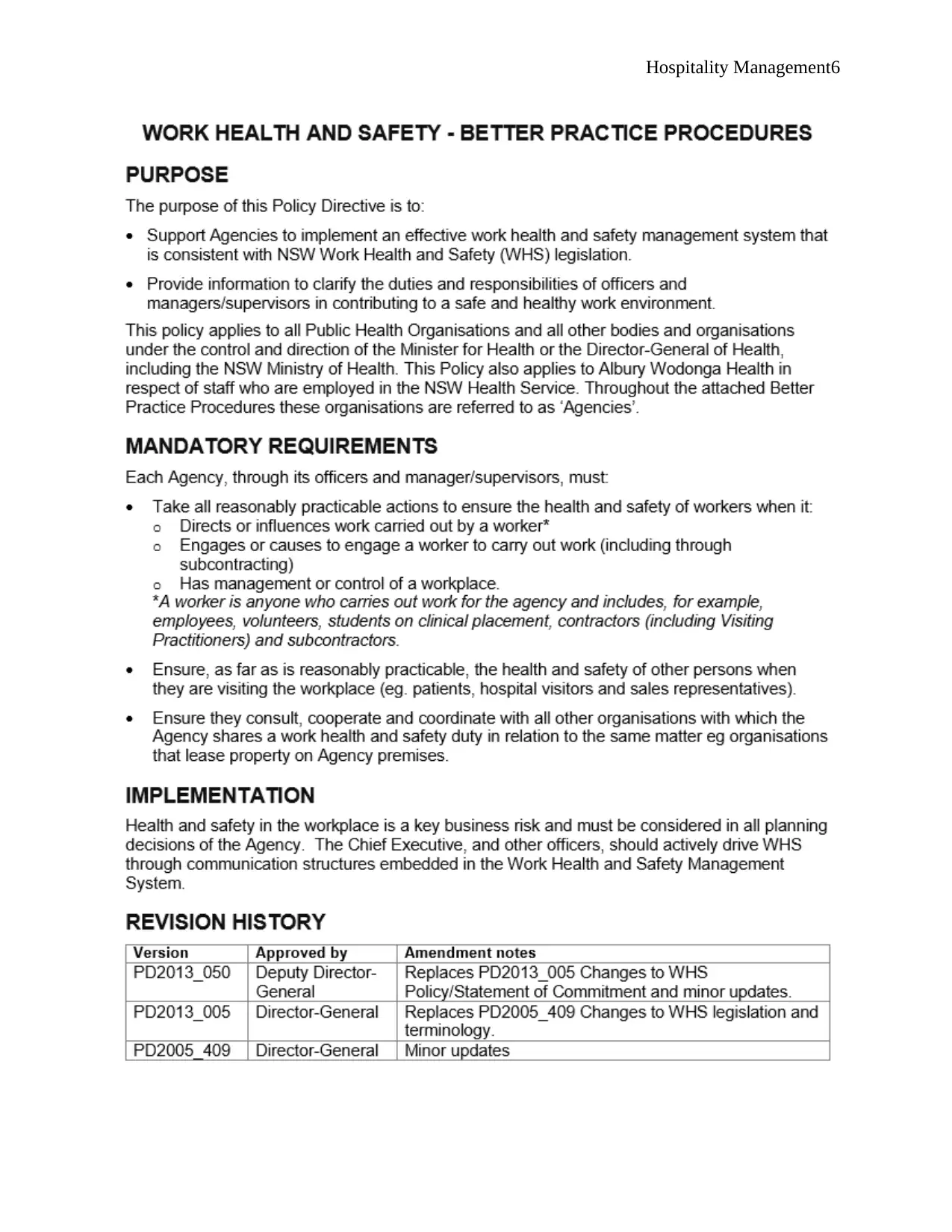
Hospitality Management6
⊘ This is a preview!⊘
Do you want full access?
Subscribe today to unlock all pages.

Trusted by 1+ million students worldwide
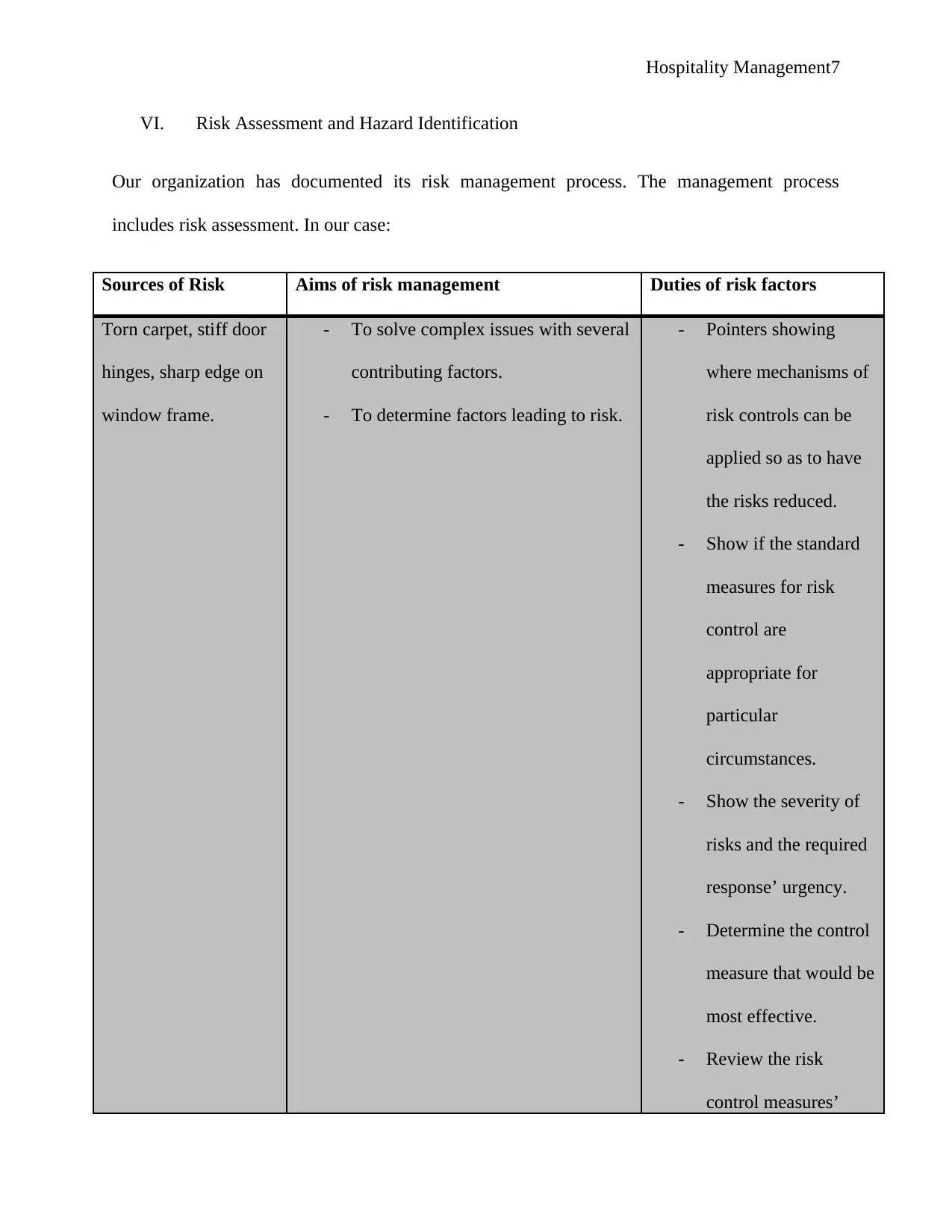
Hospitality Management7
VI. Risk Assessment and Hazard Identification
Our organization has documented its risk management process. The management process
includes risk assessment. In our case:
Sources of Risk Aims of risk management Duties of risk factors
Torn carpet, stiff door
hinges, sharp edge on
window frame.
- To solve complex issues with several
contributing factors.
- To determine factors leading to risk.
- Pointers showing
where mechanisms of
risk controls can be
applied so as to have
the risks reduced.
- Show if the standard
measures for risk
control are
appropriate for
particular
circumstances.
- Show the severity of
risks and the required
response’ urgency.
- Determine the control
measure that would be
most effective.
- Review the risk
control measures’
VI. Risk Assessment and Hazard Identification
Our organization has documented its risk management process. The management process
includes risk assessment. In our case:
Sources of Risk Aims of risk management Duties of risk factors
Torn carpet, stiff door
hinges, sharp edge on
window frame.
- To solve complex issues with several
contributing factors.
- To determine factors leading to risk.
- Pointers showing
where mechanisms of
risk controls can be
applied so as to have
the risks reduced.
- Show if the standard
measures for risk
control are
appropriate for
particular
circumstances.
- Show the severity of
risks and the required
response’ urgency.
- Determine the control
measure that would be
most effective.
- Review the risk
control measures’
Paraphrase This Document
Need a fresh take? Get an instant paraphrase of this document with our AI Paraphraser
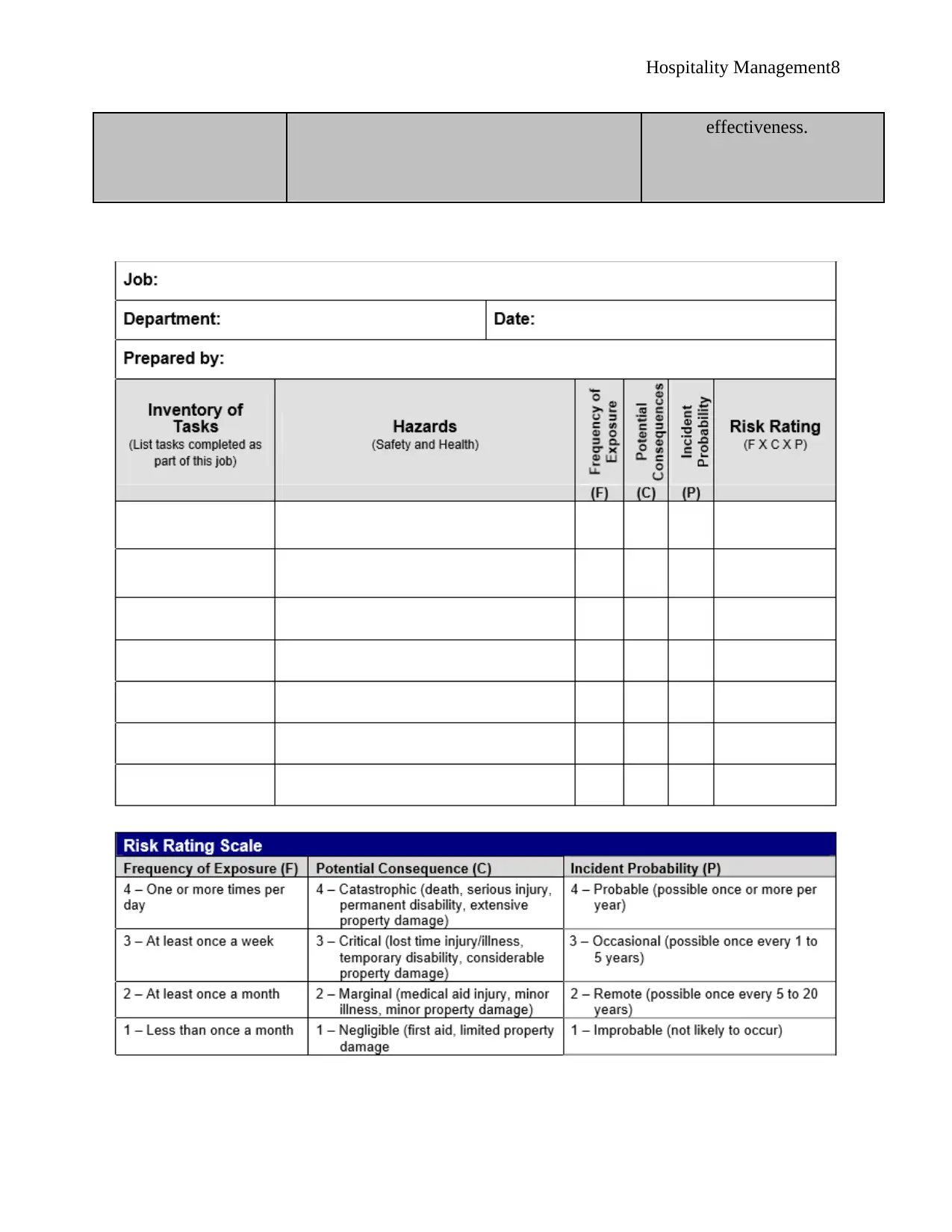
Hospitality Management8
effectiveness.
effectiveness.
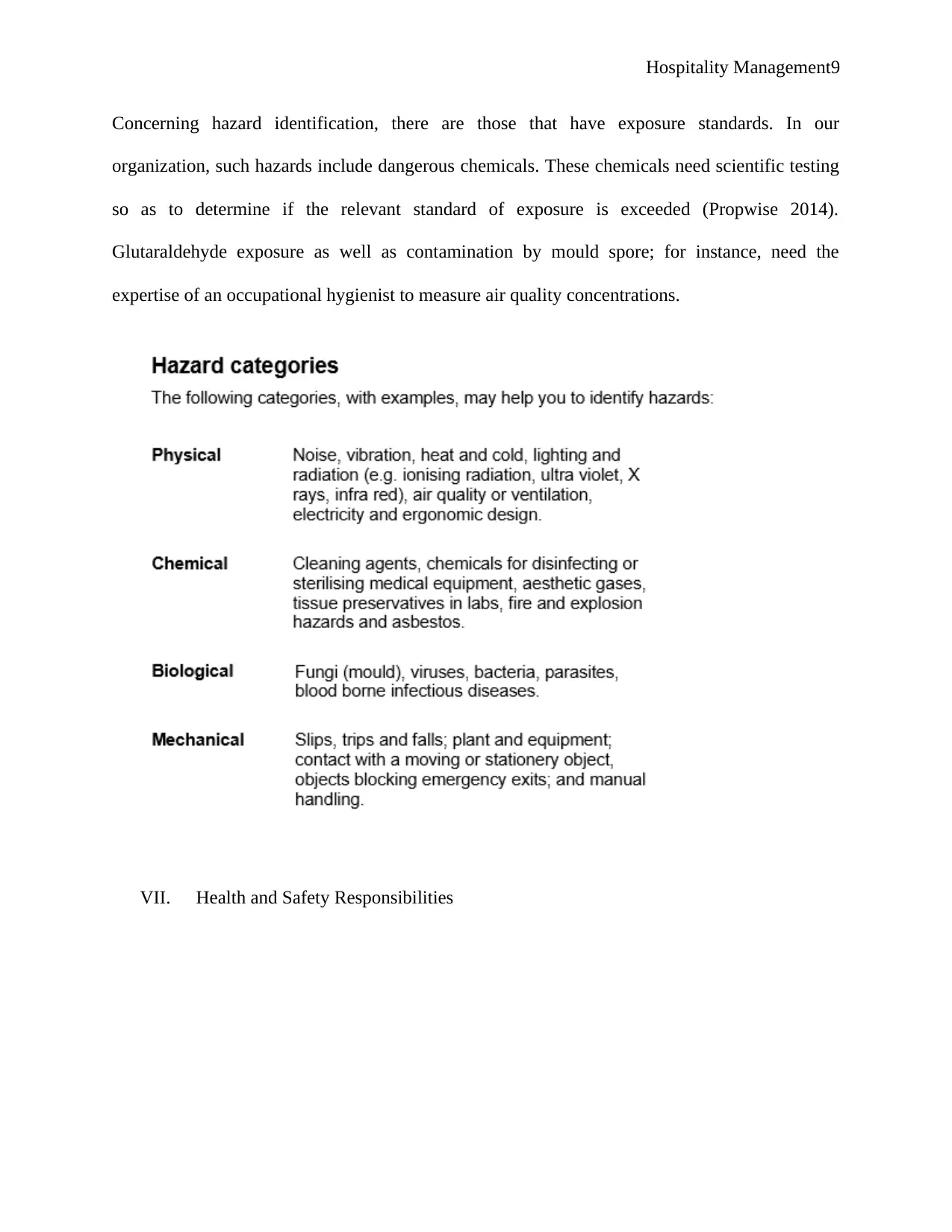
Hospitality Management9
Concerning hazard identification, there are those that have exposure standards. In our
organization, such hazards include dangerous chemicals. These chemicals need scientific testing
so as to determine if the relevant standard of exposure is exceeded (Propwise 2014).
Glutaraldehyde exposure as well as contamination by mould spore; for instance, need the
expertise of an occupational hygienist to measure air quality concentrations.
VII. Health and Safety Responsibilities
Concerning hazard identification, there are those that have exposure standards. In our
organization, such hazards include dangerous chemicals. These chemicals need scientific testing
so as to determine if the relevant standard of exposure is exceeded (Propwise 2014).
Glutaraldehyde exposure as well as contamination by mould spore; for instance, need the
expertise of an occupational hygienist to measure air quality concentrations.
VII. Health and Safety Responsibilities
⊘ This is a preview!⊘
Do you want full access?
Subscribe today to unlock all pages.

Trusted by 1+ million students worldwide
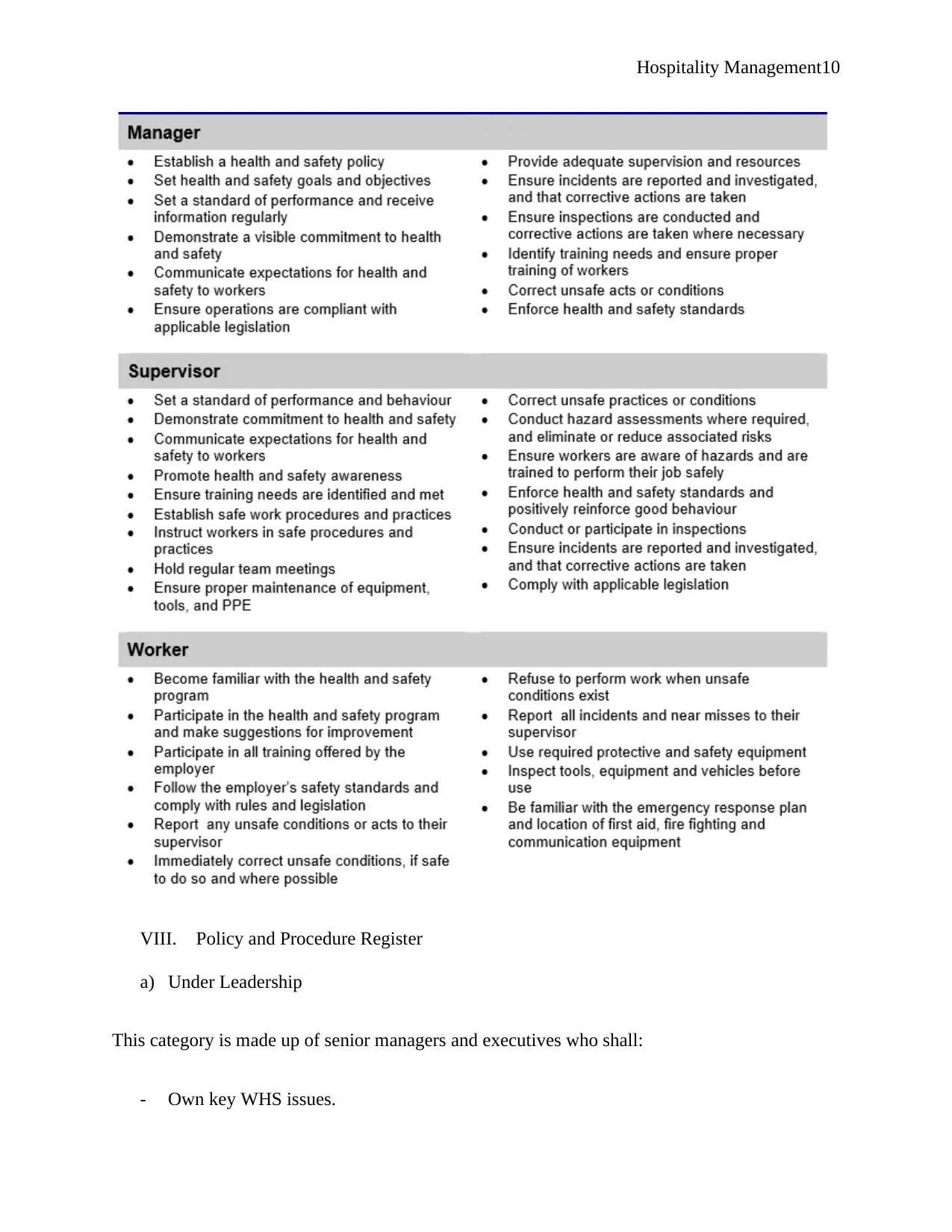
Hospitality Management10
VIII. Policy and Procedure Register
a) Under Leadership
This category is made up of senior managers and executives who shall:
- Own key WHS issues.
VIII. Policy and Procedure Register
a) Under Leadership
This category is made up of senior managers and executives who shall:
- Own key WHS issues.
Paraphrase This Document
Need a fresh take? Get an instant paraphrase of this document with our AI Paraphraser
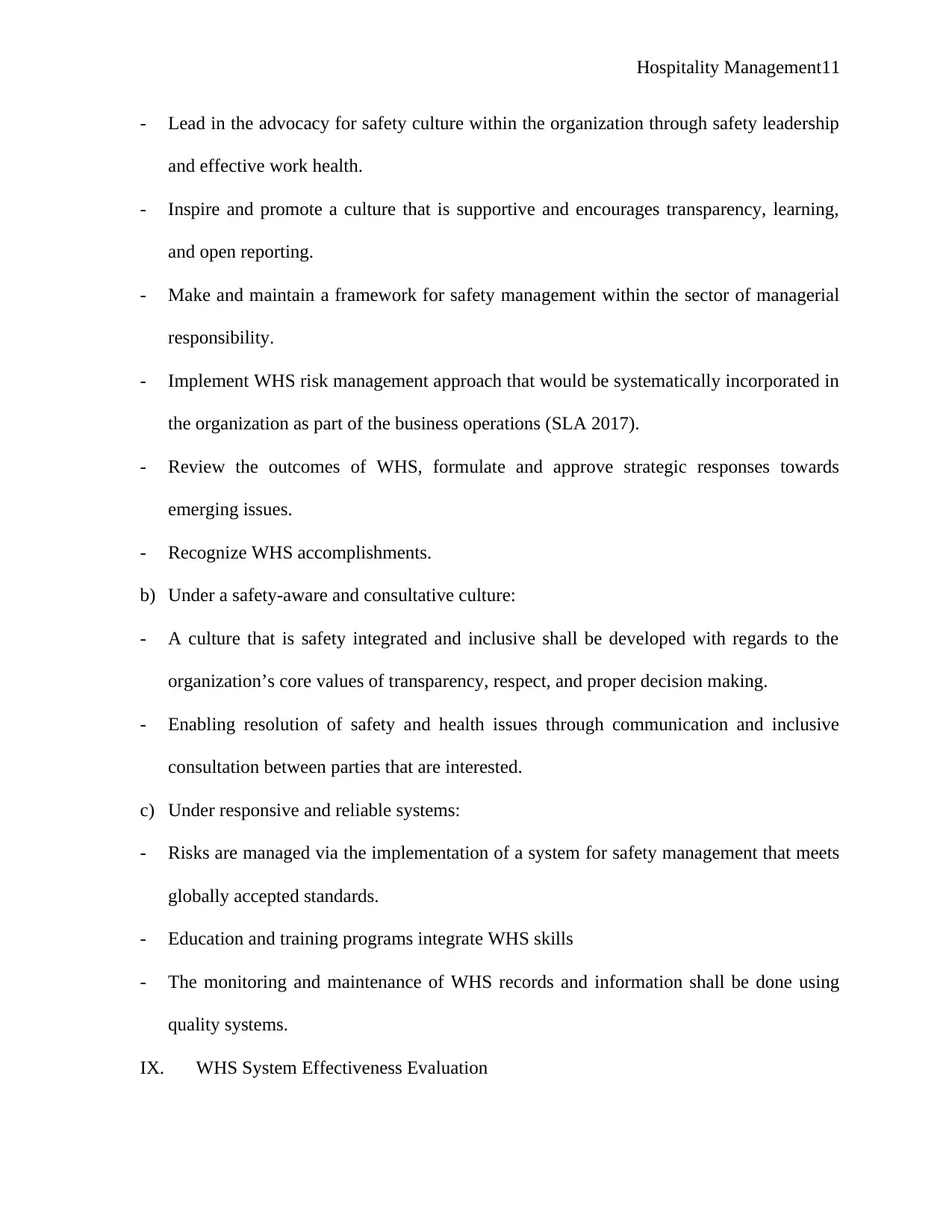
Hospitality Management11
- Lead in the advocacy for safety culture within the organization through safety leadership
and effective work health.
- Inspire and promote a culture that is supportive and encourages transparency, learning,
and open reporting.
- Make and maintain a framework for safety management within the sector of managerial
responsibility.
- Implement WHS risk management approach that would be systematically incorporated in
the organization as part of the business operations (SLA 2017).
- Review the outcomes of WHS, formulate and approve strategic responses towards
emerging issues.
- Recognize WHS accomplishments.
b) Under a safety-aware and consultative culture:
- A culture that is safety integrated and inclusive shall be developed with regards to the
organization’s core values of transparency, respect, and proper decision making.
- Enabling resolution of safety and health issues through communication and inclusive
consultation between parties that are interested.
c) Under responsive and reliable systems:
- Risks are managed via the implementation of a system for safety management that meets
globally accepted standards.
- Education and training programs integrate WHS skills
- The monitoring and maintenance of WHS records and information shall be done using
quality systems.
IX. WHS System Effectiveness Evaluation
- Lead in the advocacy for safety culture within the organization through safety leadership
and effective work health.
- Inspire and promote a culture that is supportive and encourages transparency, learning,
and open reporting.
- Make and maintain a framework for safety management within the sector of managerial
responsibility.
- Implement WHS risk management approach that would be systematically incorporated in
the organization as part of the business operations (SLA 2017).
- Review the outcomes of WHS, formulate and approve strategic responses towards
emerging issues.
- Recognize WHS accomplishments.
b) Under a safety-aware and consultative culture:
- A culture that is safety integrated and inclusive shall be developed with regards to the
organization’s core values of transparency, respect, and proper decision making.
- Enabling resolution of safety and health issues through communication and inclusive
consultation between parties that are interested.
c) Under responsive and reliable systems:
- Risks are managed via the implementation of a system for safety management that meets
globally accepted standards.
- Education and training programs integrate WHS skills
- The monitoring and maintenance of WHS records and information shall be done using
quality systems.
IX. WHS System Effectiveness Evaluation
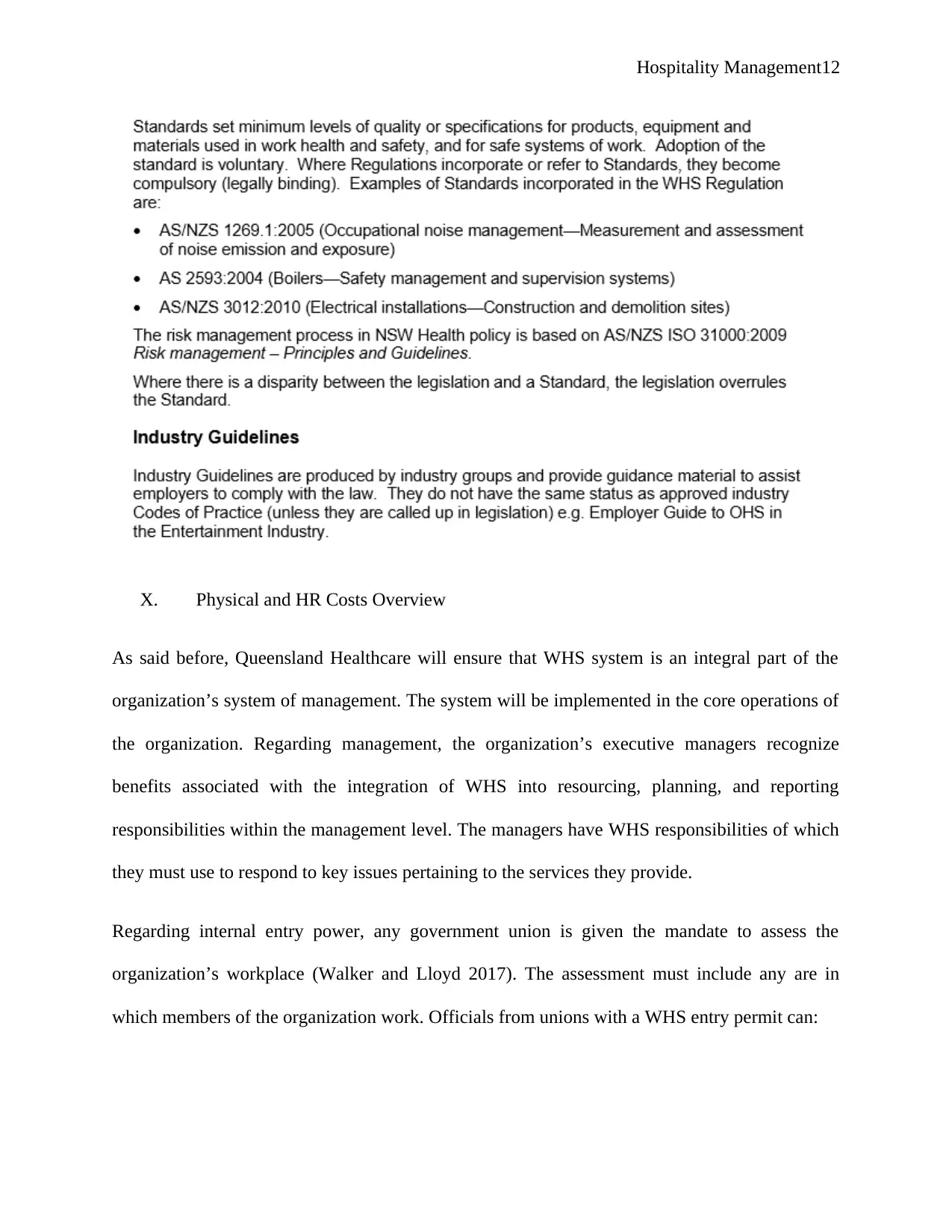
Hospitality Management12
X. Physical and HR Costs Overview
As said before, Queensland Healthcare will ensure that WHS system is an integral part of the
organization’s system of management. The system will be implemented in the core operations of
the organization. Regarding management, the organization’s executive managers recognize
benefits associated with the integration of WHS into resourcing, planning, and reporting
responsibilities within the management level. The managers have WHS responsibilities of which
they must use to respond to key issues pertaining to the services they provide.
Regarding internal entry power, any government union is given the mandate to assess the
organization’s workplace (Walker and Lloyd 2017). The assessment must include any are in
which members of the organization work. Officials from unions with a WHS entry permit can:
X. Physical and HR Costs Overview
As said before, Queensland Healthcare will ensure that WHS system is an integral part of the
organization’s system of management. The system will be implemented in the core operations of
the organization. Regarding management, the organization’s executive managers recognize
benefits associated with the integration of WHS into resourcing, planning, and reporting
responsibilities within the management level. The managers have WHS responsibilities of which
they must use to respond to key issues pertaining to the services they provide.
Regarding internal entry power, any government union is given the mandate to assess the
organization’s workplace (Walker and Lloyd 2017). The assessment must include any are in
which members of the organization work. Officials from unions with a WHS entry permit can:
⊘ This is a preview!⊘
Do you want full access?
Subscribe today to unlock all pages.

Trusted by 1+ million students worldwide
1 out of 15
Related Documents
Your All-in-One AI-Powered Toolkit for Academic Success.
+13062052269
info@desklib.com
Available 24*7 on WhatsApp / Email
![[object Object]](/_next/static/media/star-bottom.7253800d.svg)
Unlock your academic potential
Copyright © 2020–2025 A2Z Services. All Rights Reserved. Developed and managed by ZUCOL.





